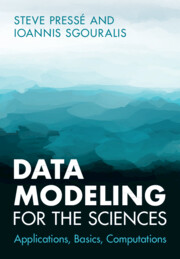Book contents
- Frontmatter
- Dedication
- Epigraph
- Contents
- Preface
- Acknowledgements
- Expanded Note for Instructors
- Part I Concepts from Modeling, Inference, and Computing
- Part II Statistical Models
- 6 Regression Models
- 7 Mixture Models
- 8 Hidden Markov Models
- 9 State-Space Models
- 10 Continuous Time Models
- Part III Appendices
- Index
- Back Cover
8 - Hidden Markov Models
from Part II - Statistical Models
Published online by Cambridge University Press: 17 August 2023
- Frontmatter
- Dedication
- Epigraph
- Contents
- Preface
- Acknowledgements
- Expanded Note for Instructors
- Part I Concepts from Modeling, Inference, and Computing
- Part II Statistical Models
- 6 Regression Models
- 7 Mixture Models
- 8 Hidden Markov Models
- 9 State-Space Models
- 10 Continuous Time Models
- Part III Appendices
- Index
- Back Cover
Summary
In this chapter we introduce and apply hidden Markov models to model and analyze dynamical data. Hidden Markov models are one of simplest of dynamical models valid for systems evolving in a discrete state-space at discrete time points. We first describe the evaluation of the likelihood relevant to hidden Markov models and introduce the concept of filtering. We then describe how to obtain maximum likelihood estimators using expectation maximization. We then broaden our discussion to the Bayesian paradigm and introduce the Bayesian hidden Markov model. In this context, we describe the forward filtering backward sampling algorithm and Monte Carlo methods for sampling from hidden Markov model posteriors. As hidden Markov models are flexible modeling tools, we present a number of variants including the sticky hidden Markov model, the factorial hidden Markov model, and the infinite hidden Markov model. Finally, we conclude with a case study in fluorescence spectroscopy where we show how the basic filtering theory presented earlier may be extended to evaluate the likelihood of a second-order hidden Markov model.
Keywords
Information
- Type
- Chapter
- Information
- Data Modeling for the SciencesApplications, Basics, Computations, pp. 264 - 317Publisher: Cambridge University PressPrint publication year: 2023
